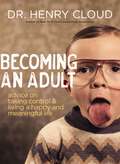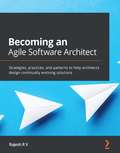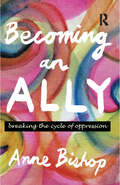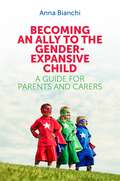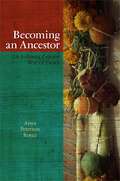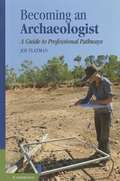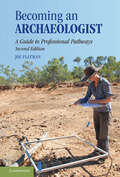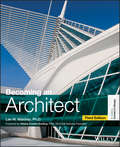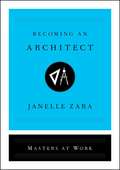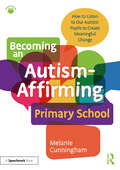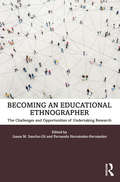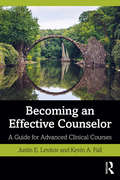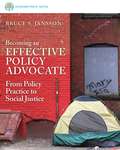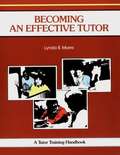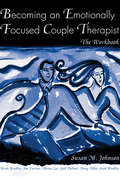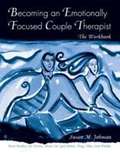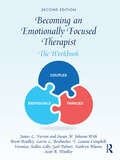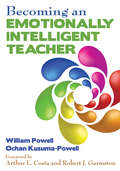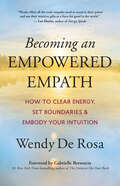- Table View
- List View
Becoming an Administrative Expert: Leverage HR Practices to Deliver Results
by Dave UlrichIn recent years, line managers and HR professionals have had to discover more efficient ways to get work done. As HR professionals reengineer their delivery of services, they become administrative experts creating efficient infrastructures, both for HR processes and for their businesses as a whole.
Becoming an Adult: Advice on Taking Control and Living a Happy, Meaningful Life
by Henry CloudA faith-based instruction manual to help you discover the fulfilling life you were meant to live.In Becoming an Adult, Dr. Henry Cloud—co-author of the bestselling classic Boundaries—focuses on the growth, connections, separations, and choices that everyone must experience to achieve emotional intelligence and health.Dr. Cloud, one of today's most trusted voices in the field of mental healthcare, highlights key issues many of us face as we navigate adulthood. With clear, insightful, and easy-to-follow guidelines, Becoming an Adult will enable you to:Address issues of dependency, authority, and boundaries.Reevaluate beliefs, decision-making, and discipline.Learn how to bond with others and strengthen existing relationships.Identify a better sense of self and grow both emotionally and spiritually.Explore how to align your path with your own interests and beliefs.You can become a healthy, productive, and faithful adult in society. Dr. Cloud will help you get there.
Becoming an Agile Software Architect: Strategies, practices, and patterns to help architects design continually evolving solutions
by Rajesh R VA guide to successfully operating in a lean-agile organization for solutions architects and enterprise architectsKey FeaturesDevelop the right combination of processes and technical excellence to address architectural challengesExplore a range of architectural techniques to modernize legacy systemsDiscover how to design and continuously improve well-architected sustainable softwareBook DescriptionMany organizations have embraced Agile methodologies to transform their ability to rapidly respond to constantly changing customer demands. However, in this melee, many enterprises often neglect to invest in architects by presuming architecture is not an intrinsic element of Agile software development. Since the role of an architect is not pre-defined in Agile, many organizations struggle to position architects, often resulting in friction with other roles or a failure to provide a clear learning path for architects to be productive. This book guides architects and organizations through new Agile ways of incrementally developing the architecture for delivering an uninterrupted, continuous flow of values that meets customer needs. You'll explore various aspects of Agile architecture and how it differs from traditional architecture. The book later covers Agile architects' responsibilities and how architects can add significant value by positioning themselves appropriately in the Agile flow of work. Through examples, you'll also learn concepts such as architectural decision backlog,the last responsible moment, value delivery, architecting for change, DevOps, and evolutionary collaboration. By the end of this Agile book, you'll be able to operate as an architect in Agile development initiatives and successfully architect reliable software systems.What you will learnAcquire clarity on the duties of architects in Agile developmentUnderstand architectural styles such as domain-driven design and microservicesIdentify the pitfalls of traditional architecture and learn how to develop solutionsUnderstand the principles of value and data-driven architectureDiscover DevOps and continuous delivery from an architect's perspectiveAdopt Lean-Agile documentation and governanceDevelop a set of personal and interpersonal qualitiesFind out how to lead the transformation to achieve organization-wide agilityWho this book is forThis agile study guide is for architects currently working on agile development projects or aspiring to work on agile software delivery, irrespective of the methodology they are using. You will also find this book useful if you're a senior developer or a budding architect looking to understand an agile architect's role by embracing agile architecture strategies and a lean-agile mindset. To understand the concepts covered in this book easily, you need to have prior knowledge of basic agile development practices.
Becoming an Ally: Breaking the cycle of oppression
by Anne BishopAlready I have found myself quoting Anne Bishop's wisdom: her simple advice is compelling. Right now in Australia she has the power to lead us as we struggle with questions of guilt, responsibility and patterns of oppression which are 'larger than ourselves'. Rev. Tim Costello, President, Baptist Union of AustraliaBecoming an Ally is must reading for anyone concerned with understanding and challenging the dynamics, forms, and sources of oppression-whether it is their own oppression, that of others, or both.Bob Mullaly is Head of Social Work at Victoria University, Melbourne Where does oppression come from? Has it always been with us, just 'human nature'? What can we do to change it? What does individual healing have to do with the struggles for social justice? What does social justice have to do with individual healing? Why do members of the same oppressed group fight each other, sometimes more viciously than their oppressor? Why do some who experience oppression develop a life-long commitment to fighting oppression, while others turn around and oppress others? Anne Bishop draws on her many years experience in community work to write this feisty and bestselling guide for activists, community workers and welfare workers.
Becoming an Ally to the Gender-Expansive Child: A Guide for Parents and Carers
by Anna BianchiWhen Anna Bianchi's grandchild asked, "Nanny, you do know I'm a girl, don't you?", Anna recognised this as a pivotal, and daunting, moment in their relationship. She knew that to answer her grandchild, who had been assigned male at birth, her own attitudes, assumptions and beliefs about gender would need to be examined. With reassuring honesty and openness, Anna draws deeply on four areas: her own experience, current research, interviews with children and their families, and a discussion of power, both in society and between children and adults. She shows how the inner journey of the adult inevitably impacts on the outer journey of the child and, given the significance of this, offers a step-by-step guide to becoming an ally to the gender-expansive child. For anyone eager to understand their child's gender experience, or to learn how best to accept, support and protect them, this book will provide knowledge, reassurance and the confidence to do so.
Becoming an Ancestor: The Isthmus Zapotec Way of Death
by Anya Peterson RoycePowerful and beautifully written, this is the story of the Isthmus Zapotecs of southern Mexico and their unbroken chain of ancestors and collective memory over the generations. Mortuary beliefs and actions are collective and pervasive in ways not seen in the United States, a resonant deep structure across many domains of Zapotec culture.Anthropologist Anya Peterson Royce draws upon forty years of participant research in the city of Juchitán to offer a finely textured portrait of the vibrant and enduring power of death in the Isthmus of Tehuantepec of Mexico. Focusing especially on the lives of Zapotec women, Becoming an Ancestor highlights the aesthetic sensibility and durability of mortuary traditions in the past and present. An intricate blending of Roman Catholicism and indigenous spiritual tradition, death through beliefs and practices expresses a collective solidarity that connects families, binds the living and dead, and blurs the past and present.A model of ethnographic research and presentation, Becoming an Ancestor not only reveals the luminescent heart of Zapotec culture but also provides important clues about the cultural power and potential of mortuary traditions for all societies.
Becoming an Archaeologist
by Joe Flatman"Becoming an Archaeologist: A Guide to Professional Pathways is an engaging handbook on career paths in the area of archaeology. It outlines in straightforward fashion the entire process of getting a job in archaeology, including the various options; the training that is required; and how to get positions in the academic, commercial, and government worlds. It also includes discussion of careers in related heritage professions such as museums and conservation societies. The book includes a series of interviews with real archaeologists, all young professionals who began their careers within the last ten years. These insider guides offer essential tips on how they got their first job and progressed in their careers. Written in an accessible style, the book is essential reading for anyone interested in the realities of archaeology in the 21st century"--
Becoming an Archaeologist: A Guide to Professional Pathways
by Joseph FlatmanBecoming an Archaeologist: A Guide to Professional Pathways is an engaging handbook on career paths in archaeology. It outlines the process of getting a job in archaeology, including various career options, the training required, and how to get positions in the academic, commercial, government and charity sectors. This new edition has been substantially revised and updated. The coverage has been expanded to include many more examples of archaeological lives and livelihoods from dozens of countries around the world. It also has more interviews, with in-depth analyses of the career paths of over twenty different archaeologists working around the world. Data on the demographics of archaeologists has also been updated, as have sections on access to and inclusion in archaeology. The volume also includes revised and updated appendices and a new bibliography. Written in an accessible style, the book is essential reading for anyone interested in a career in archaeology in the twenty-first century.
Becoming an Architect
by Lee W. WaldrepWhat do architects do? What are the educational requirements for architects? What does an architectural internship involve? How does one become a licensed architect? What is the future of the architectural profession?If you're considering a career in architecture, start with this highly visual guide to preparing for and succeeding in the profession. Through fascinating interviews with working professionals in the field, Becoming An Architect, Second Edition gives you an inside view of what it takes to be an architect, including an overview of the profession, educational requirements, design specialties from which to choose, the job search, registration requirements, and the many directions in which a career in architecture can go.Expanded and revised to include the most current issues that are impacting architects' work, such as BIM and integrated practice, this essential guide will prepare you for successfully entering this competitive yet rewarding profession.
Becoming an Architect (Masters at Work)
by Janelle ZaraAn illuminating guide to a career as an architect written by art and design journalist Janelle Zara and based on the real-life experiences of two experts in the field—required reading for someone considering a path to this rewarding profession.Go behind the scenes and be mentored by the best to find out what it&’s really like, and what it really takes, to become an architect. Design critic Janelle Zara takes readers to the front lines to offer a candid portrait of this challenging profession. What does it actually mean to be an architect today? What do they do? How do they do it? Zara shadows acclaimed architects Sharon Johnston and Mark Lee of the prestigious Los Angeles-based firm Johnston Marklee. Learn from the founders as they near the unveiling of their major new building, the Menil Drawing Institute. Sit in on meetings as they compete for new projects, and watch as they conceive, draft, render, plan, construct, and execute buildings. Architects must juggle hundreds of items to ensure their ideas come to life as planned. Zara shows that good architects must have artistic vision as well as organizational acumen. An accessible and informed primer on a hot profession, Becoming an Architect is the most valuable informational interview you&’ll have—required reading for anyone considering this dream job.
Becoming an Artwork (Theory Redux)
by Boris GroysModern history is a history of aesthetizations – and every aesthetization raises a claim of protection. We aestheticize and want to protect almost everything, including Earth, oceans, the atmosphere, rare animal species and exotic plants. Humans are no exception. They also present themselves as objects of contemplation that deserve admiration and care. For some time, artists and intellectuals struggled for the sovereign right to present themselves to society in their own way – to become self-created works of art. Today everybody has not only a right but also an obligation to practice self-design. We are responsible for the way we present ourselves to others – and we cannot get rid of this aesthetic responsibility. However, we are not able to produce our own bodies. Before we begin to practice self-design, we find ourselves already designed by the gaze of others. That is why the practice of self-design mostly takes a critical and confrontational turn. We want to bring others to see us in the way we want to be seen – not only during our earthly life but also after our death. This is a complicated struggle, and the aim of this book is to describe and analyze it.
Becoming an Astronaut (An\astronaut's Life Ser.)
by Martha E. H. RustadWhat does it take to become an astronaut? How do astronauts train to be in outer space? Readers will learn all about what it's like to become an astronaut. Low-leveled, chunked text alongside stunning photographs will engage the youngest space enthusiasts.
Becoming an Autism-Affirming Primary School: How to Listen to Our Autistic Pupils to Create Meaningful Change
by Melanie CunninghamThis accessible guide explores what an autism-affirming primary school should be like, from the perspective of autistic pupils, introducing a tool to gather pupil voice and sharing a toolbox of strategies informed and requested by autistic children themselves. The book presents a fun and engaging approach, the three houses, which can be used with autistic children to generate a greater understanding of how they are experiencing school and how they may be masking their difficulties.Chapters focus on common themes, from developing a shared, positive understanding of autism throughout the school, to consideration of the classroom environment, hidden support, homework and routines. By identifying simple adjustments to practice, schools can create a more positive experience for autistic children, building self-advocacy and helping to alleviate feelings of anxiety. The book includes a wealth of easy-to-implement, practical strategies that place an emphasis on whole-school approaches, as well as opportunities for readers to reflect on their current practice. Quotes from autistic children, describing their experiences, are woven throughout the book.Becoming an Autism-Affirming Primary School keeps the voices of autistic pupils at its core and is a valuable read for primary school teachers, SENCos and senior leaders to ensure they are offering much-needed support for autistic children, which will also be of benefit to their non-autistic peers. Parents may find it useful to generate an understanding of how their autistic children might be experiencing school and autistic children themselves may find the narrative from other autistic children valuable.
Becoming an Educational Ethnographer: The Challenges and Opportunities of Undertaking Research
by Juana M. Sancho-Gil and Fernando Hernández-HernándezThis book provides practical advice on the learning and teaching perspectives of ethnography, including what undertaking research looks like and the experiences it will bring. It considers what it means to be and become an educational ethnographer and builds on an inextricable entanglement between the researchers’ field of study and their research trajectories. With a range of carefully chosen international contributions, this book uses a variety of practical case studies to provide further information about the pros and cons of this research perspective. Chapter authors share the knowledge and experience gained from the research and how it has affected their approach to social phenomena. This book is an ideal introduction for anyone considering research approach or becoming an educational ethnographer and will be of interest to researchers already working in this field.
Becoming an Effective Counselor: A Guide for Advanced Clinical Courses
by Kevin A. Fall Justin E. LevitovBecoming an Effective Counselor is a textbook for advanced clinical courses that guides counselors in training through the most challenging phases of their academic preparation. Chapters blend skills-based content, real-world student examples, and opportunities for personal reflection to help students navigate some of the most difficult aspects of clinical counseling. Written by authors with over 50 years of combined counseling experience, this volume prepares aspiring counselors to assess their progress, remediate deficiencies, and deepen their existing skills in a way that is attentive to both core counseling skills and counselors’ internal processes.
Becoming an Effective Family Therapist: Research, Practice, and Case Stories
by Peter RoberThis book explores the link between the effectiveness of the family therapist and the complexity of the therapeutic relationship.For family therapists the therapeutic alliance is complex because there are different family members and the therapist must have an empathic relationship with each of them. Furthermore, the therapist is focused on facilitating the development of trust between the family members. The book highlights the family therapist, not as an interventionist, but as someone who is focused on establishing a good relationship with different family members. Centering the person of the therapist, this book includes research, theory, as well as case studies exploring topics such as the therapist’s emotion regulation, the therapist’s inner dialogue, and dealing with client feedback. Rober offers an empathetic perspective and accessible framework for family therapists, encouraging readers to use their intuition and self-supervision to build better awareness and stronger connections in the session.This book is essential for beginning and seasoned family therapists, systemic therapists, and graduate students.
Becoming an Effective Policy Advocate: From Policy Practice to Social Justice, 7th Edition
by Bruce S. JanssonThe seventh edition’s coverage includes discussion of such events and issues as Barack Obama’s presidency, the Occupy Wall Street movement, the Arab Spring, and more. By going beyond the traditional foundational approach to policy, this groundbreaking text helps you develop the skills you need to become an advocate for social change.
Becoming an Effective Supervisor: A Workbook for Counselors and Psychotherapists
by Jane CampbellA practical, hands-on workbook, Becoming an Effective Supervisor neatly fills the gap in supervision resources available to mental health practitioners. The workbook is designed to help clinical counselors and therapists create effective supervision programs of their own, and to address the individual needs of their students. The leading contemporary models of supervision are discussed, as well as the necessary components of a successful supervision curriculum.A framework is then provided for counselors and therapists to develop a personalized and highly effective supervisory style to implement with their own students. The unique exploration exercises in each chapter allow readers to actively integrate the information provided, and to apply these lessons and skills to their own supervisory experiences. Students too will benefit from her concise examination of the theories, applications, and goals of the supervision process. Along with a discussion of the ethical, legal, and multicultural issues faced by clinical supervisors, practical analyses and applications ensure that this book will be a valued addition to any clinical counseling or therapy library.
Becoming an Effective Tutor
by Linda MyersDiscussion of what is necessary to appropriately tutor college-level students and what skills tutors ought to have.
Becoming an Emotionally Focused Couple Therapist: The Workbook
by Susan M. Johnson James L. Furrow Alison Lee Gail Palmer Scott Woolley Lorrie Brubacher Kathryn RheemAn invaluable tool for clinicians and students, Becoming an Emotionally Focused Therapist: The Workbook takes the reader on an adventure – the quest to become a competent, confident, and passionate couple and family therapist. In an accessible resource for training and supervision, seven expert therapists lead the reader through the nine essential steps of EFT with explicit intervention strategies. Suitable as a companion volume to The Practice of Emotionally Focused Couple Therapy, 2nd Ed. or as a stand-alone learning tool, the workbook provides an easy road-map to mastering the art of EFT with exercises, review sheets and practice models. Unprecedented in its novel and interactive approach, this is a must-have for all therapists searching for lasting and efficient results in couple therapy.
Becoming an Emotionally Focused Couples Therapist: The Workbook
by Susan M. Johnson Brent Bradley Jim Furrow Alison Lee Gail Palmer Doug Tilley Scott WoolleyThis workbook is designed to help therapists and counsellors use the emotionally focused perspective and interventions to transform couple and family relationships.
Becoming an Emotionally Focused Therapist: The Workbook
by James L. Furrow Susan M. Johnson Brent Bradley Lorrie Brubacher T. Leanne Campbell Veronica Kallos-Lilly Gail Palmer Kathryn Rheem Scott WoolleyThis second edition of Becoming an Emotionally Focused Therapist: The Workbook has been fully revised by expert therapists with advances in attachment science and emotionally focused therapy (EFT) practice, the integration of the "EFT Tango"—a guide to the EFT process—and new chapters on working with both individuals and families. Suitable as a companion volume to The Practice of Emotionally Focused Couple Therapy or as a standalone learning tool, it provides an easy road-map toward mastering the ins and outs of EFT with practice exercises, review questions, and compelling clinical examples. Invaluable for clinicians and students, this workbook takes the reader on an adventure: the quest to become a competent, confident, and passionate emotionally focused therapist.
Becoming an Emotionally Intelligent Teacher
by William R. Powell Ochan Kusuma-PowellWhat kind of teacher are YOU? Teacher behaviors and personalities can have an effect on student achievement. Based on Daniel Goleman’s five components of emotional intelligence, this guide shows how self-awareness, self-regulation, motivation, social awareness, and relationship management can help teachers increase their effectiveness in the classroom. The authors provide research, case studies, and essential exercises that help teachers: Understand how their conscious and unconscious behaviors affect the learning environment Refine their verbal and nonverbal communication skills Manage their feelings and frustrations Interpret student behaviors, developing insight into how students perceive teachers Hone their presentation skills
Becoming an Employee Champion: Leverage HR Practices to Deliver Results
by Dave UlrichThis chapter reviews the role of HR as employee champion and discusses specific ways that managers and HR professionals can increase employee commitment and competence, despite post-reengineering trauma and burned-out employees, and keep employees committed in an era of increasing competitiveness.
Becoming an Empowered Empath: How to Clear Energy, Set Boundaries & Embody Your Intuition
by Wendy De RosaThrive as the Divinely Connected Intuitive You Were Born to Be &“Wendy is precisely the spiritual mentor I would pray for you to find. By opening this book, you will receive the energetic nurturing that she has infused into every page.&” — Gabrielle Bernstein, from the foreword As an empathic person, you likely feel the energy of the unseen world and unknowingly take on other people&’s energy and emotions. This can lead to anxiety, overwhelm, and chronic health issues. Personal growth work alone is not enough to shift this lifelong pattern. In Becoming an Empowered Empath, intuitive healer and teacher Wendy De Rosa will guide you step-by-step to help you:understand your empathic naturestop taking on other people’s energydetoxify your subtle body, including your chakras and grounding cordrecognize and heal ancestral, familial, and personal traumasturn your oversensitivity into powerful intuitionThrough guided meditations, journaling exercises, and practices for energetic self-care, Wendy empowers you to embrace your gifts, embody light, and become a vital agent for positive change.

